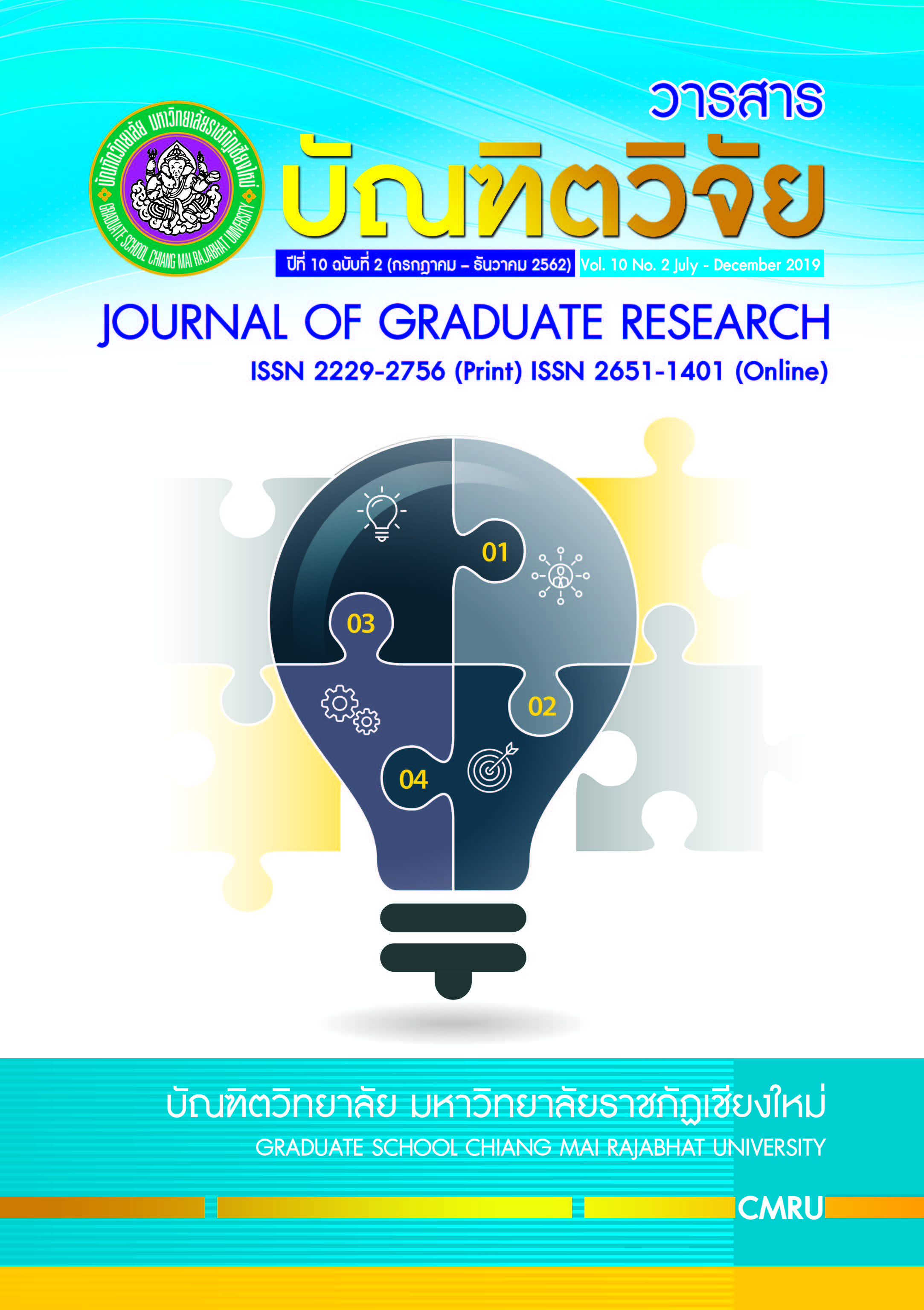The Development of Learning and Integrated Mathematical Thinking Skills by Using the 7e Learning Cycle Activities with Community Resources for Mathayomsuksa 2 Students
Main Article Content
Abstract
This research study aimed to 1) develop mathematics learning activities on measurement using the 7E learning cycle together with community learning resources for Matthayom 2 students at Soemngam witthayakhom School under the Office of Secondary Education Service Area 35, 2) investigate the students’ mathematics learning achievement on measurement using 7E learning cycle together with community learning resources, and 3) examine the students’ integrated thinking skills in mathematics. The sample was a class of 34 Matthayom 2 students in the first semester of the 2018 Academic year at Soemngamwitthayakhom School chosen by the cluster sampling method. The study was based on an educational innovation research and development. Statistics employed to analyze the data were percentage, mean, standard deviation, coefficient of variation, mode, t-test (Paired-test) and Z-test.
The findings revealed that
- The mathematics lesson plans using the 7E learning cycle together with community learning resources for Matthayom 2 students on measurement included lesson plans on the history of measurement, length measurement, area measurement, volume measurement, weight measurement, and time measurement. Learning resources and materials integrated during the learning activities consisted of parts of a human body, classrooms, school buildings, a library, a canteen, a temple, rectangular prism boxes, cylindrical cans, students, family members, clocks and calendars. The lesson plans had the effectiveness ratio of 79.22/84.19 which was higher than the pre-determined criterion of 75/75.
- The students’ mathematics learning achievement on measurement in the aspects of knowledge after the learning activities was higher than before with a statistical significance of .01. More than seventy percent of them possessed the mathematical process skills at a high level or above. As for the evaluation of the students’ integrity and desirable characteristics, over fifty-eight percent of the students was rated at a very high level.
- For students’ integrated thinking skills in mathematics, more than seventy percent of the students established the skills at a high level or above with the statistical significance of .05.
Downloads
Article Details
References
กระทรวงศึกษาธิการ. (2552). แนวปฏิบัติการวัดและประเมินผลการเรียนรู้. กรุงเทพฯ: ชุมนุมสหกรณ์การเกษตรแห่งประเทศไทย.
กระทรวงศึกษาธิการ. (2553). พระราชบัญญัติการศึกษาแห่งชาติ พุทธศักราช 2553 (ฉบับที่ 3). กรุงเทพฯ: สยามสปอร์ต ซินดิเคท .
ฐิติพงศ์ จันทสีร์. (2559). การศึกษาความสามารถในการคิดเชิงบูรณาการของนักเรียนชั้นประถมศึกษา ปีที่ 5 โรงเรียนราชวินิต โดยใช้การจัดการเรียนรู้แบบบูรณาการ. (สารนิพนธ์ศึกษาศาสตรมหาบัณฑิต, สาขาวิชาหลักสูตรและการสอน มหาวิทยาลัยนอร์ทกรุงเทพ)
ธันยนันท์ อ่อนหนองหว้า. (2559). การจัดการเรียนรู้แบบสืบเสาะหาความรู้ 7 ขั้น ร่วมกับแผนผังมโนมติ เรื่องบรรยากาศ ชั้นมัธยมศึกษาปีที่ 1. (วิทยานิพนธ์ครุศาสตรมหาบัณฑิต, สาขาวิชาหลักสูตรและการเรียนการสอน มหาวิทยาลัยราชภัฏมหาสารคาม).
นิภาพรรณ์ สิงห์คำ, วีระศักดิ์ ชมพูคำ และพิชญ์สินี ชมภูคำ. (2560). การพัฒนาชุดกิจกรรมการจัดการเรียนรู้คณิตศาสตร์ โดยใช้รูปแบบการเรียนรู้แบบร่วมมือควบคู่กับโปรแกรม GSP เพื่อส่งเสริมผลสัมฤทธิ์ทางการเรียนและทักษะความคิดสร้างสรรค์ สำหรับนักเรียนชั้นมัธยมศึกษาปีที่ 2. วารสารบัณฑิตวิจัย, 9(2), 1-20.
พัชรี ผลความดี. (2557). การเปรียบเทียบผลสัมฤทธิ์ทางการเรียนวิชาคณิตศาสตร์ เรื่องอสมการ ของนักเรียนชั้นมัธยมศึกษาปีที่ 3 ระหว่างการจัดการเรียนรู้แบบเสาะหาความรู้ 7 ขั้น (7E) และการจัดการเรียนรู้โดยใช้รูปแบบ SSCS. (วิทยานิพนธ์วิทยาศาสตรมหาบัณฑิต, สาขาวิชาคณิตศาสตร์ศึกษา มหาวิทยาลัยบูรพา).
รัตนะ บัวสนธ์. (2552). การวิจัยและพัฒนานวัตกรรมการศึกษา. กรุงเทพฯ: คำสมัย.
เรวัตร เพ็งด้วง. (2561). ผลการจัดการเรียนรู้วิชาชีววิทยา เรื่อง สิ่งมีชีวิตกับสิ่งแวดล้อม ด้วยการจัดการเรียนรู้แบบวัฏจักร 7 ขั้น ร่วมกับการใช้ผังกราฟิก เพื่อพัฒนาการคิดวิเคราะห์ทางวิทยาศาสตร์ ผลสัมฤทธิ์ทางการเรียนและความคงทนในการเรียนรู้ ของนักเรียนชั้นมัธยมศึกษา ปีที่ 4. (วิทยานิพนธ์วิทยาศาสตรมหาบัณฑิต, สาขาวิชาชีววิทยาศึกษา มหาวิทยาลัยบูรพา).
ศิลารัตน์ สุริยวงศ์. (2554). ผลการใช้วิธีการจัดการเรียนรู้แบบ 7 อี เรื่อง แสงและการเกิดภาพ ที่มีต่อความคงทนในการเรียนรู้และจิตวิทยาศาสตร์ ของนักเรียนชั้นมัธยมศึกษาปีที่ 2. (วิทยานิพนธ์ศึกษาศาสตรมหาบัณฑิต,สาขาวิชาหลักสูตรและการสอน มหาวิทยาลัยสุโขทัยธรรมาธิราช).
สถาบันทดสอบทางการศึกษาแห่งชาติ องค์การมหาชน. (2560). ประกาศผลสอบ O-NET ม.3 ปีการศึกษา 2560. สืบค้นจาก https://www.newonetresult.niets.or.th/Announcement Web/School/ReportSchoolBySchool. aspx?mi=2
สถาบันส่งเสริมการสอนวิทยาศาสตร์และเทคโนโลยี. (2555). การวัดผลและประเมินผลคณิตศาสตร์. กรุงเทพฯ: วี.พริ้น.
สันติ สีลา. (2553). ผลของการบูรณาการปรัชญาของเศรษฐกิจพอเพียง ในวัฏจักรการเรียนรู้ 7 ขั้น หน่วยภาวะโลกร้อน ของนักเรียนชั้นประถมศึกษาปีที่ 3. (วิทยานิพนธ์ศึกษาศาสตรมหาบัณฑิต, สาขาวิชาสิ่งแวดล้อมศึกษา มหาวิทยาลัยขอนแก่น).
สุคนธ์ สินธพานนท์. (2554). วิธีสอนตามแนวปฏิรูปการศึกษาเพื่อพัฒนาคุณภาพของเยาวชน. กรุงเทพฯ: จุฬาลงกรณ์มหาวิทยาลัย.
สำนักงานคณะกรรมการการศึกษาขั้นพื้นฐาน. (2546). บทบาทของครูในการเรียนรู้แบบ Active Learning. สืบค้นจาก https://www.kroobannok.com/20651
ไอริณ ถาวรณันท์. (2561). ผลการจัดกิจกรรมการเรียนรู้คณิตศาสตร์ ตามวัฏจักรการเรียนรู้ 7 ขั้น โดยใช้โปรแกรม GeoGebra เรื่อง การวิเคราะห์ข้อมูล ของนักเรียนชั้นมัธยมศึกษาปีที่ 6. (วิทยานิพนธ์วิทยาศาสตรมหาบัณฑิต, สาขาวิชาคณิตศาสตร์ศึกษา มหาวิทยาลัยบูรพา)


